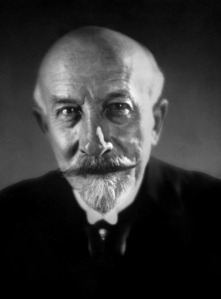Great Movies – Le voyage dans la lune (1902)
Director: Georges Méliès
Starring: Georges Méliès, Victor André, Bleuette Bernon, Brunnet, Jeanne d’Alcy, Henry Delannoy, Depierre, Farjaut, Kelm
 The image of a rocket stuck into the eye of the anthropomorphic-faced moon in Georges Méliès’ 1902 film Le voyage dans la lune (A Trip to the Moon) is among the most famous and enduring in cinematic history. The film itself, which tells the story of a scientific expedition to the moon, the resulting encounters with aliens, and the return journey via the bottom of the ocean, is undoubtedly the first great movie.
The image of a rocket stuck into the eye of the anthropomorphic-faced moon in Georges Méliès’ 1902 film Le voyage dans la lune (A Trip to the Moon) is among the most famous and enduring in cinematic history. The film itself, which tells the story of a scientific expedition to the moon, the resulting encounters with aliens, and the return journey via the bottom of the ocean, is undoubtedly the first great movie.
Often referred to as the father of narrative filmmaking, Georges Méliès is arguably the first cinematic master. Directing more than 500 films between 1896 and 1913, the majority of which he also wrote, produced and starred in, Méliès can be credited with establishing many of the elements which would become the foundations of what we know as the cinema. The moving picture medium was invented by the Lumière brothers, Auguste and Louis, in the late 19th century. They toured their short, fifty second films around the world and were wildly popular, but at this point, the attraction was the medium itself, moving pictures, rather than the specific content of their films. The Lumières’ films were all actuality films – a primitive form of documentary simply concerned with the capturing of real events – the most famous of which was 1896’s L’arrivée d’un train à La Ciotat (Arrival of a Train at La Ciotat), which featured a train pulling into a platform and caused audiences to scream and duck for cover as the train approached the screen. It was Méliès who, having become fascinated with the Lumières’ invention, saw the potential of this new medium for imagination and fictional storytelling. Nowhere is this imagination more apparent than in the fantastic narrative of La voyage dans la lune. As Martin Scoresese put it, “the Lumières gave us the world as we knew it, and Méliès gave it to us as we imagined and extended it.”
Before becoming a filmmaker, Méliès had been a magician, and that background in theatricality and illusion would be incredibly influential on his filmmaking. While his earliest films were simply recreations of his stage shows, he soon began to experiment with the technology and as a result became responsible for the development of many of the earliest forms of special effects including stop motion, time-lapse photography, multiple exposures and dissolves. For a film made only seven years after the Lumières first introduced the medium to the world, Le voyage dans la lune features a staggeringly sophisticated use of both staged visual effects and more complicated editing effects. With each scene being a single shot from a stationary camera, the sets are able to function much like traditional theatre sets, with openings and trapdoors which characters can come in and out of. The iconic image of the face on the moon was achieved through superimposing one image shot over another. We have characters appearing and disappearing into puffs of smoke through the use of jump cutting, the very same principle I Dream of Jeannie would employ 65 years later. The picture was released in both black-and-white and colour prints, with the colour prints having been hand coloured, frame-by-frame. This magician really put the wonder and magic into moviemaking.
Not only did Le voyage dans la lune feature a fantastical story – the first ever sci-fi movie – and innovative use of the medium, at a time when the average film only ran for one or two minutes, La voyage dans la lune’s fifteen minute runtime (at the then standard 16 frames per second) made it positively epic by comparison.
In 1993, the Filmoteca de Catalunya in Barcelona discovered a hand-coloured print of the film, the only one known to have survived, that had almost completely decomposed. In 1999 the Technicolor Lab of Los Angeles launched a frame-by-frame restoration project which would take over a decade. The completed restoration, with a new soundtrack by the French band, Air, was screened at the 2011 Cannes Film Festival almost 110 years after its initial release, and has been released on DVD and Blu-Ray.
By Duncan McLean




One comment